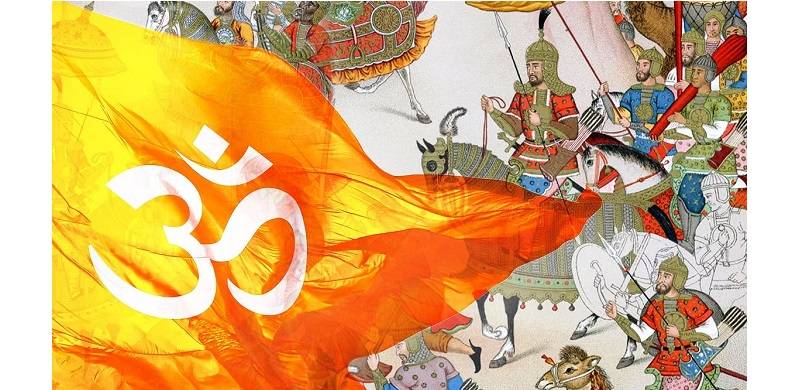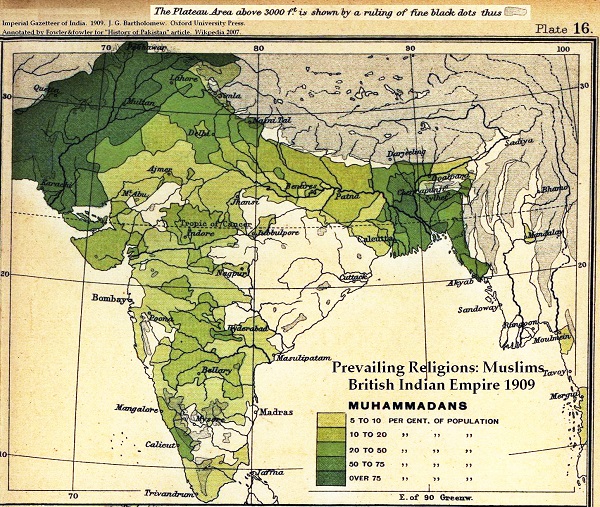
Some recent publications have dealt with the concept of the Two Nation Theory but unfortunately, these disappoint as they are based on the same half-truths that we were already being fed in the name of enlightenment. The myth starts in the 1880s with Sir Syed Ahmed Khan declaring Muslims and Hindus as separate nations and then jumping straight to the so-called Pakistan Resolution in 1940.
Anyone who has reads the relevant history in detail knows that after the establishment of Crown Rule in 1857-58, the first people who classified Muslims and Hindus as separate nations were the Hindu revivalists. In 1867, Nabagopal Mitra founded Hindu Mela, an organisation tasked with awakening the Hindus as a nation. In 1872, he clearly declared, "Hindus are a nation [...] The basis of national unity in India is the Hindu religion."
Nabagopal Mitra and Rajnarayan Basu later co-founded another organisation in 1887 by the name of Bharat Dharma Mahamandala. Its goal was to create a Hindu Raj or Aryan State. Later this organisation inspired leaders from the radical branch of Congress to found Hindu Mahasabha in 1915. Later, from the platform of Hindu Mahasabha, KB Hedgewar was mentored by BS Moonje, a former Congress leader. Hedgewar then founded RSS in 1925.
This is a brief history of the Two Nation Theory as far as British Raj is concerned. However, things don't happen overnight. The concept of Hindus being a separate nation is pretty old, and predates the British Raj. In fact, it is as old as the Brahmin priestly class. The word Mleccha was used in ancient Sanskrit literature for those who didn't follow the caste system. Mleccha in Sanskrit means barbarians who come from distant lands and speak inferior and uncivilised foreign languages.
This word was also used by prominent Congress leaders from Punjab, like Lala Lajpat Rai, for the Muslims. They saw their fellow Punjabi non-Brahmins as separate and inferior. Rai in 1924 also gave the idea of separate sovereign states for Hindus and Muslims which would be created by dividing Punjab and Bengal in half.
Inscriptions from the 9th century on the ancient buildings of Gwalior tell about Arab invasions of the 8th century, led by Junaid and Tamim. They were defeated by Nagabhata I, the founder of the Gurjara-Pratihara dynasty. These inscriptions classify Arab Muslims as an inferior nation and talk about the triumph of Nagabhata I by stating, "[He] crushed the large armies of the powerful Mleccha king, the destroyer of virtue. He shone with four arms, brilliant on account of the glittering terrible weapons."

Looking at history, one finds that Brahmins didn't just classify different races as separate nations but also those who didn't follow their lifestyle. For example, lower castes of Hindus, outcasts and those who didn't practise their religious rituals or vegetarian diet were also degraded to Mleccha status. Sometimes converts from other religions were also classified as separate entities. It took the converts a few generations before they were given the status of a superior nation. This approach then led to various religious communities in the Subcontinent getting classified as separate nations even if they belonged to the same region, society or race.
Another example is Maharana Kumbha, a ruler of 15th-century Mewar. Back then Nagaur was being ruled by Firuz Khan. Kumbha attacked his kingdom and became victorious. A tower by the name of Vijay Stambha, also known as the Tower of Victory, was constructed between 1440 and 1470. The tower inscriptions tell the tale of Kumbha's battle with the Muslims of Nagaur.
It says, "Kumbha is like the mountain Sumeru for the churning of the sea of Malwa [...] He also destroyed other lowly Mleccha rulers of the neighbourhood [...] He rescued twelve lakh [1,200,000] cows from the Muslim possession and converted Nagaur into a safe pasture for them. He brought Nagaur under the control of the Brahmanas and secured cows and Brahmanas in this land [...] Nagaur was the centre of the Mleccha. Kumbha uprooted this tree of evil."
Classifying Muslims as a separate nation itself isn't objectionable. Historically, a nation is just a group of people who have something in common which binds them together. It can be religion, language, region, ethnicity, same goals, common enemy and so on. The issue was seeing non-Brahmins, especially Muslims, as an inferior group who 'didn't belong in the subcontinent'. As BS Moonje said, "Just as [...] Germany belongs to the Germans, India belongs to the Hindus [...] The Hindus henceforth can create their own world which will prosper through forced conversions."
So what was Sir Syed Ahmed Khan's response to this ideology? He claimed that Hindus and Muslims were like two eyes of the same bride. This meant, both had different ways of living but deserved to live together in peace. In January 1940, just a few weeks before Lahore Resolution, Jinnah stated, "There are in India two nations, who both must share the governance of their common motherland." A year later, during his address to Mysore University, he called for a constitution which would allow Muslim-majority areas (Pakistan) and Hindu-majority areas (Hindustan) to share power in the centre.
After the failure of the Cabinet Mission Plan, when a separate Pakistan became inevitable, Jinnah still wanted the entire Punjab and Bengal provinces in Pakistan. One of the reasons behind this was to have a non-Muslim population of East Punjab and West Bengal in Pakistan, hence, raising the percentage of the non-Muslim population in Pakistan and non-Hindu population in Hindustan, forcing both regions to remain secular to accommodate millions of minorities living within them through social contracts.
But Congress very cleverly got both provinces partitioned, as per Lala Lajpat Rai's scheme of 1924, which brought the non-Muslim population in West Pakistan down to 5%.
This was the moment when anti-Pakistan clerics like Maududi decided to come to West Pakistan – because now it was easier for them to turn it into a religious state. This was admitted by Maududi himself during an investigation that took place after the riots of 1953.
Anyone who has reads the relevant history in detail knows that after the establishment of Crown Rule in 1857-58, the first people who classified Muslims and Hindus as separate nations were the Hindu revivalists. In 1867, Nabagopal Mitra founded Hindu Mela, an organisation tasked with awakening the Hindus as a nation. In 1872, he clearly declared, "Hindus are a nation [...] The basis of national unity in India is the Hindu religion."
Nabagopal Mitra and Rajnarayan Basu later co-founded another organisation in 1887 by the name of Bharat Dharma Mahamandala. Its goal was to create a Hindu Raj or Aryan State. Later this organisation inspired leaders from the radical branch of Congress to found Hindu Mahasabha in 1915. Later, from the platform of Hindu Mahasabha, KB Hedgewar was mentored by BS Moonje, a former Congress leader. Hedgewar then founded RSS in 1925.
Looking at history, one finds that Brahmins didn't just classify different races as separate nations but also those who didn't follow their lifestyle
This is a brief history of the Two Nation Theory as far as British Raj is concerned. However, things don't happen overnight. The concept of Hindus being a separate nation is pretty old, and predates the British Raj. In fact, it is as old as the Brahmin priestly class. The word Mleccha was used in ancient Sanskrit literature for those who didn't follow the caste system. Mleccha in Sanskrit means barbarians who come from distant lands and speak inferior and uncivilised foreign languages.
This word was also used by prominent Congress leaders from Punjab, like Lala Lajpat Rai, for the Muslims. They saw their fellow Punjabi non-Brahmins as separate and inferior. Rai in 1924 also gave the idea of separate sovereign states for Hindus and Muslims which would be created by dividing Punjab and Bengal in half.
Inscriptions from the 9th century on the ancient buildings of Gwalior tell about Arab invasions of the 8th century, led by Junaid and Tamim. They were defeated by Nagabhata I, the founder of the Gurjara-Pratihara dynasty. These inscriptions classify Arab Muslims as an inferior nation and talk about the triumph of Nagabhata I by stating, "[He] crushed the large armies of the powerful Mleccha king, the destroyer of virtue. He shone with four arms, brilliant on account of the glittering terrible weapons."

Looking at history, one finds that Brahmins didn't just classify different races as separate nations but also those who didn't follow their lifestyle. For example, lower castes of Hindus, outcasts and those who didn't practise their religious rituals or vegetarian diet were also degraded to Mleccha status. Sometimes converts from other religions were also classified as separate entities. It took the converts a few generations before they were given the status of a superior nation. This approach then led to various religious communities in the Subcontinent getting classified as separate nations even if they belonged to the same region, society or race.
Another example is Maharana Kumbha, a ruler of 15th-century Mewar. Back then Nagaur was being ruled by Firuz Khan. Kumbha attacked his kingdom and became victorious. A tower by the name of Vijay Stambha, also known as the Tower of Victory, was constructed between 1440 and 1470. The tower inscriptions tell the tale of Kumbha's battle with the Muslims of Nagaur.
It says, "Kumbha is like the mountain Sumeru for the churning of the sea of Malwa [...] He also destroyed other lowly Mleccha rulers of the neighbourhood [...] He rescued twelve lakh [1,200,000] cows from the Muslim possession and converted Nagaur into a safe pasture for them. He brought Nagaur under the control of the Brahmanas and secured cows and Brahmanas in this land [...] Nagaur was the centre of the Mleccha. Kumbha uprooted this tree of evil."
Classifying Muslims as a separate nation itself isn't objectionable. Historically, a nation is just a group of people who have something in common which binds them together. It can be religion, language, region, ethnicity, same goals, common enemy and so on. The issue was seeing non-Brahmins, especially Muslims, as an inferior group who 'didn't belong in the subcontinent'. As BS Moonje said, "Just as [...] Germany belongs to the Germans, India belongs to the Hindus [...] The Hindus henceforth can create their own world which will prosper through forced conversions."
So what was Sir Syed Ahmed Khan's response to this ideology? He claimed that Hindus and Muslims were like two eyes of the same bride. This meant, both had different ways of living but deserved to live together in peace. In January 1940, just a few weeks before Lahore Resolution, Jinnah stated, "There are in India two nations, who both must share the governance of their common motherland." A year later, during his address to Mysore University, he called for a constitution which would allow Muslim-majority areas (Pakistan) and Hindu-majority areas (Hindustan) to share power in the centre.
After the failure of the Cabinet Mission Plan, when a separate Pakistan became inevitable, Jinnah still wanted the entire Punjab and Bengal provinces in Pakistan. One of the reasons behind this was to have a non-Muslim population of East Punjab and West Bengal in Pakistan, hence, raising the percentage of the non-Muslim population in Pakistan and non-Hindu population in Hindustan, forcing both regions to remain secular to accommodate millions of minorities living within them through social contracts.
But Congress very cleverly got both provinces partitioned, as per Lala Lajpat Rai's scheme of 1924, which brought the non-Muslim population in West Pakistan down to 5%.
This was the moment when anti-Pakistan clerics like Maududi decided to come to West Pakistan – because now it was easier for them to turn it into a religious state. This was admitted by Maududi himself during an investigation that took place after the riots of 1953.

